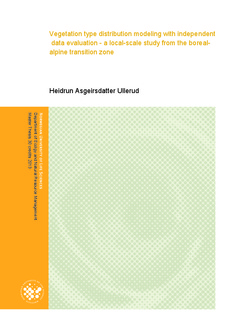| dc.contributor.author | Ullerud, Heidrun Asgeirsdatter | |
| dc.date.accessioned | 2013-08-07T10:38:12Z | |
| dc.date.available | 2013-08-07T10:38:12Z | |
| dc.date.copyright | 2013 | |
| dc.date.issued | 2013-08-07 | |
| dc.identifier.uri | http://hdl.handle.net/11250/186941 | |
| dc.description.abstract | This study investigated the performance of distribution modeling (DM) for vegetation types. Two frame-areas were mapped. One area was used to train models in Maxent, a recommended method for DM. The other area was used for model projection and evaluation by independent data. Models were created for six vegetation types, two from each of the ecosystems present in the area; forest, wetland and mountain. For each ecosystem one locally common and one locally rare vegetation type was modeled. AUC was used as the model selection criteria. Environmental variables were selected through a backwards selection scheme, where variables contributing by less than 0.005 to the AUC-value were excluded. Model complexity in Maxent was limited by allowing only three transformations; linear, quadratic and threshold, and setting the regularization multiplier to eight.
The results showed that modeling of vegetation types and projecting the models locally to a neighboring area was possible. However, the resulting models varied greatly in predictive performance between the vegetation types, as well as in number of environmental variables included and the number of parameters in the final models. With the AUC-values from training, models for rare types were found to have better predictive performance than models for common types, and a significant negative relationship was found between the number of points used to train the model and the AUC-value.
The models’ predictions were evaluated with independent data. The resulting AUC-values were found to be a better representation of the predictive performance than the training AUC-values, since the training AUC-values seemed to be affected by the characteristics of the training data. After evaluation the AUC-values portrayed less variation in model predictive performance. All six vegetation types had models that were characterized as good or excellent regardless of differences in occurrence, ecosystem, variation in environmental variables, number of points used to train the model and the complexity of the models. | no_NO |
| dc.description.sponsorship | The thesis has been supported financially by the Cultour-project (NFR 189977/I10) at The Norwegian Forest and Landscape Institute. | no_NO |
| dc.language.iso | eng | no_NO |
| dc.publisher | Norwegian University of Life Sciences, Ås | |
| dc.subject | Vegetation mapping | no_NO |
| dc.subject | Maxent | no_NO |
| dc.subject | Distribution modeling | no_NO |
| dc.subject | Evaluation | no_NO |
| dc.title | Vegetation type destribution modeling with evaluation by independent data - a local-scale study from the boreal-alpine transition zone | no_NO |
| dc.type | Master thesis | no_NO |
| dc.subject.nsi | VDP::Mathematics and natural science: 400 | no_NO |
| dc.source.pagenumber | 42 | no_NO |
